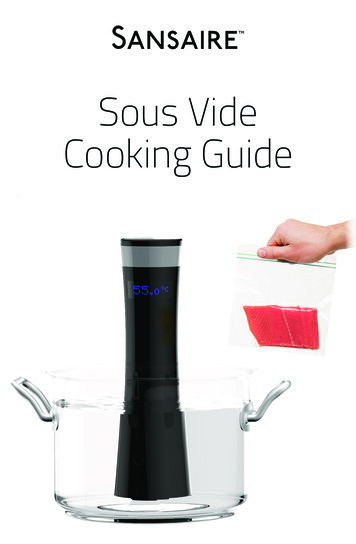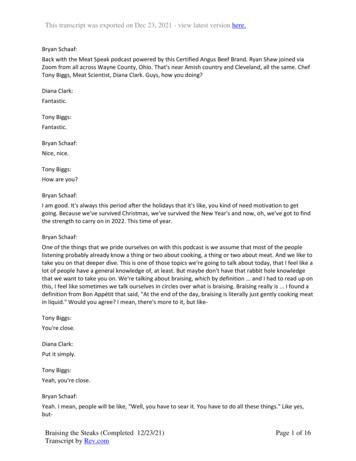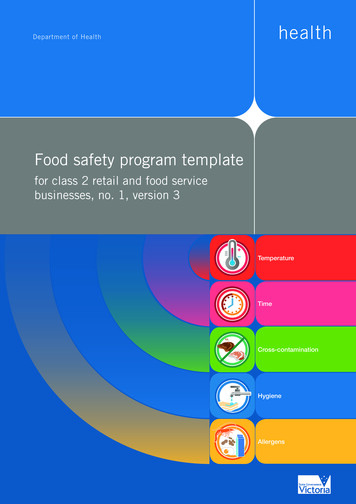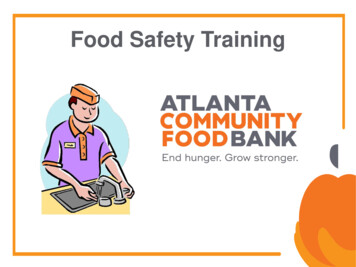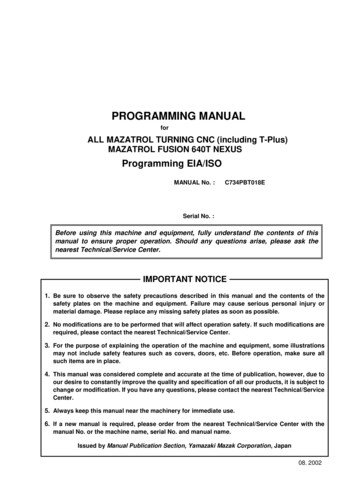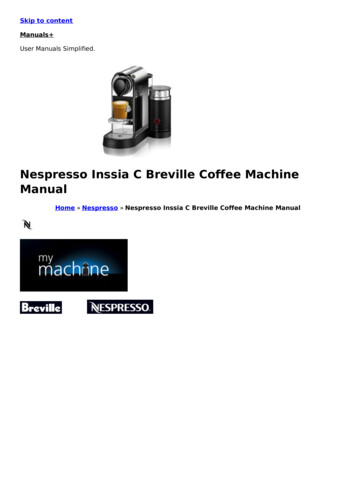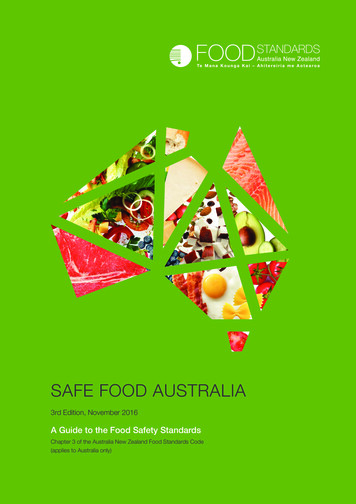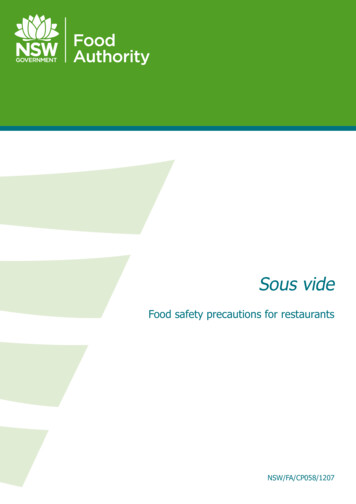
Transcription
Sous videFood safety precautions for restaurantsNSW/FA/CP058/1207
ForewordSous vide translates from the French as ‘under vacuum’. In culinary terms it has come tomean a process of cooking under vacuum in sealed pouches (oxygen barrier bags), at precise(and sometimes low) temperatures and often for long times. Sous vide can be used toprepare foods with an extended shelf life for retail sale or use in food service. However, sousvide can also be used to prepare foods with qualities that cannot be achieved when usingtraditional cooking techniques. Some sous vide recipes result in food that remains raw orundercooked.This document includes information on the service of raw and undercooked foods. Thisinformation is provided in response to a growing trend for sous vide use by restaurants and toencourage the use of safer choices for this type of product: it is not an endorsement of theservice of raw or undercooked foods. The onus of delivering a safe product to the consumerresides with the business.The Food Standards Code says that a food business must:where a process step is needed to reduce to safe levels any pathogens that may bepresent in the food, use a process step that is reasonably known to achieve themicrobiological safety of the food.Cooking is a process known to achieve the microbiological safety of food and by choosing toserve raw or undercooked animal foods restaurateurs must acknowledge that there will be aresidual public health and business risk.Section 1.6 of this document provides details on the public health risks of raw andundercooked foods. As an alternative to the service of raw or undercooked foods chefs shouldfirst consider the service of cooked food prepared using times and temperatures from Table 2or Table 3 that follow.Sous vide – Food safety precautions for restaurants CP058/1207Page 1 of 29
ContentsForeword. 1Contents . 2Executive summary . 3Introduction . 4Sous vide processing . 5Concerns about food safety . 6Food safety hazards . 71.1Low temperature cooking – bacterial growth . 71.2Product cooling – bacterial growth . 121.3Extended refrigerated storage of food – botulism . 141.4Extended refrigerated storage of food – listeriosis . 151.5Product reheating – bacterial growth . 161.6Serving raw or undercooked foods – infectious bacteria, parasites or viruses . 20Conclusion . 24References . 25Appendix: Variation to the 4-hour/2-hour rule . 28Sous vide – Food safety precautions for restaurants CP058/1207Page 2 of 29
Executive summaryThere are several types of sous vide foods. This document is about food safety hazards ofcook serve and short term cook chill sous vide foods. Some issues are common to extendedshelf life sous vide foods but guidance on the preparation of these foods is readily available.Sous vide seems like a new food service technology but it has a history spanning fourdecades in France and two decades in other international marketplaces. It finds applicationin many market segments including extended shelf life ready meals. It is also found incatering companies, restaurants and, increasingly, sous vide has been embraced by homecooks.There is a history of sous vide food causing concern to regulators. There is little evidence ofsous vide food causing outbreaks of foodborne illness. However there are foreseeablehazards in three broad areas that must be managed:1. Foods held in the temperature danger zone, defined as 5 C to 60 C by the AustraliaNew Zealand Food Standards Code, for extended periods are potentially subject tobacterial growth, for example, during low temperature long time (LT LT) cookingprocesses, product cooling or product reheating.2. Foods stored under refrigeration for extended periods are potentially subject togrowth by cold tolerant pathogens. The growth of Listeria monocytogenes is a risk asis growth and toxin production by non-proteolytic Clostridium botulinum.3. Food cooked at low temperatures for short periods will, in essence, remain raw andpathogenic bacteria and parasites, if present, might survive.The risks associated with sous vide foods will be reduced if: thinner portions of food are prepared so that heating and cooling are rapid.water bath temperatures of at least 55 C are used so that the growth ofClostridium perfringens is first prevented and then destruction of the cellscommences. the time food is held below 54.5 C during cooking is limited to six hours. commercial equipment with adequate heating capacity and excellent temperaturecontrol is used. water and/or food temperatures are checked using a tip sensitive digitalthermometer that is accurate to 0.1 C. prepared foods are not stored for extended times unless processes have beenvalidated. risks are not compounded. Cooking large portions of mechanically tenderisedmeat for extended times at low temperatures would be irresponsible. if you choose to include on your menu foods that remain essentially raw theyshould only be served following a request by an informed, healthy adult whowillingly accepts the risks associated with raw foods.New practitioners of sous vide must be aware of the food safety risks and avoid overlyexperimental applications of the technology. Today’s leaders in sous vide produce qualityfood without losing sight of food safety.Sous vide – Food safety precautions for restaurants CP058/1207Page 3 of 29
IntroductionThis chart illustrates the variety of processes used to prepare sous vide foods. The blockswith bold font and pink-striped fill relate to extended shelf life products such as ready mealsor foods produced by some large caterers. The guidance in this document does not addressspecific issues relating to extended shelf life sous vide products, for example those with ashelf life greater than ten days.The Wide Spectrum of Sous VidePrepareSmall portions of food invacuum pouchesCook90 / 10minEquivalent70 / 2minEquivalentCookRapid chillRapid chillRapid chillHeat withoutcookingChillStore 5 ESL* ifvalidated 3 ESL ifvalidated 5 SSL* 5 only shortterm storagerecommendedRapid reheatRapid reheatRapid reheatRapid reheatCook chill orcook serveCook chillCook chill orcook serveCook chill orcook serveRe-heatServeCook serve* ESL Extended shelf lifeSSL Short shelf lifeFigure 1: Sous vide processingSous vide – Food safety precautions for restaurants CP058/1207Page 4 of 29
Sous vide processingSous vide translates from the French as ‘under vacuum’. In culinary terms it has come tomean a process of cooking under vacuum in sealed pouches (oxygen barrier bags), atprecise (and sometimes low) temperatures and often for long times. Creed (1998) quotesthe widely accepted definition developed by the Sous Vide Advisory Committee (SVAC):Sous vide (also known as Cuisine en Papillote Sous Vide) is an interrupted 1 cateringsystem in which raw or par-cooked food is sealed in a vacuumed laminated plasticpouch or container, heat treated by controlled cooking, rapidly cooled, and thenreheated for service after a period of chilled storage.Sous vide can be used to prepare foods with an extended shelf life for retail sale or use infood service. In these examples the ‘interrupted catering system’ is the relevantcharacteristic. However, sous vide can also be used to prepare foods with qualities thatcannot be achieved when using traditional cooking techniques. In this instance ‘in-pouch’cooking under precise and often delicate conditions provides the sought-after characteristicsand refrigerated or frozen storage might not be part of the process.The wide range of products known as sous vide can be divided into four broad categories. Processed 90/10. Heated to reduce the numbers of non-proteolytic Clostridiumbotulinum by 99.9999%. This moderately severe process is likely to be used for retailready meals or extended shelf life cook chill foods. One conventional process calls forthe slowest heating part of the food to be exposed to a combination of temperatureand time equivalent to 90 C for 10 minutes. Lower temperatures can be used butexposure times increase significantly. Processed 70/2. Heated to reduce the numbers of Listeria monocytogenes by99.9999%. This is commonly known as food pasteurisation and it could be used byrestaurants, caterers and some manufacturers of extended shelf life foods. Oneconventional process calls for the slowest heating part of the food to be exposed to acombination of temperature and time equivalent to 70 C for 2 minutes. Lowertemperatures can be used but exposure times increase significantly. Cooked. This term mainly refers to taste, texture and appearance but it has alsobecome associated with certain minimum heating processes for meats. Cooked butnot necessarily pasteurised foods will be encountered in restaurants and home sousvide. One process specified by the US Food Safety Inspection Service (FSIS, 2011)calls for the slowest heating part of the food to be heated to 63 C followed by a 3minute rest time. Lower temperatures can be used to prepare rare meats butexposure times increase significantly. Higher temperatures are specified for poultryand mechanically tenderised, injected, comminuted or stuffed meats. Extended timescan be used to tenderise cheaper cuts of meat. Lightly processed. Some sous vide recipes do not result in cooked food. Anycontaminant bacteria or parasites that might be present are likely to survive.In food service operations sous vide foods will generally be cooked in a finely controlledcirculating water bath or a combination steam/forced convection oven. Larger cateringcompanies or manufacturers preparing ready meals might use an enclosed vessel(sometimes called a retort) with a water cascade system to first heat and then cool thepouches of food.1Interrupted – implies a holding step, as in cook chill as opposed to cook serve for immediate useSous vide – Food safety precautions for restaurants CP058/1207Page 5 of 29
Concerns about food safetySous vide has been embraced by a number of celebrity chefs and use of the technique isspreading in culinary circles. A similar surge in popularity of sous vide in New York CBDrestaurants, in part, resulted in an effective ban on ‘reduced oxygen packaging’ (ROP)pending individual approval from the city’s Department of Health and Mental Hygiene (NYTimes, 2006). One concern was that chefs trained in sous vide, aware of the hazards, hadbeen joined by those who were not aware. The Department was concerned that ROPsuppressed the growth of spoilage bacteria while providing a suitable environment forpathogens such as Listeria monocytogenes and Clostridium botulinum. To gain approval touse ROP, food establishments were required to have a food safety plan for each food itemand multiple barriers against the growth of Listeria and Clostridium were required (eg pH,water activity).Retail sous vide foods such as ready meals and, more generally, vacuum packed andmodified atmosphere chilled foods, have a good record of food safety. The Institute of FoodResearch (Peck et al 2006) found no cases of foodborne botulism could be attributed tocorrectly stored commercial chilled foods in the UK or overseas. Guidance on the preparationof sous vide ready meals and cook chill foods generally is readily available—see Cox andBauler (2008), UKFSA (2008) and FSAI (2006). This document does not address food safetyrisks for ready meals and other extended shelf life foods, although many of the issues ofrestaurant sous vide overlap with those for extended shelf life foods.The extent of foodborne illness attributable to restaurant prepared sous vide is not as clear,but reports of foodborne illness are at least rare, and no reports of illness explicitly namingsous vide foods have been found in the scientific literature or outbreak databases. However,there are foreseeable hazards that must be managed. Sous vide literature has focussed onbotulism, but there are other potential hazards that have received less attention. Sous videhazards fall into three areas: Foods held in the temperature danger zone (5 C to 60 C) for extended periods arepotentially subject to bacterial growth, for example, duringolow temperature long time (LT LT) cooking processes,oproduct cooling, oroproduct reheating. Foods stored under refrigeration for extended periods are potentially subject togrowth by cold tolerant pathogens. The growth of Listeria monocytogenes is a risk,as is growth and toxin production by non-proteolytic Clostridium botulinum. Food cooked at low temperatures for short periods will, in essence, remain raw andpathogenic bacteria, viruses and parasites, if present, might survive.The established wisdom relating to food safety should not be ignored by experimental chefs.This wisdom has mainly been acquired—the hard way—through food poisoning incidents.Today’s leaders in sous vide produce new and interesting food without losing sight of foodsafety.Sous vide – Food safety precautions for restaurants CP058/1207Page 6 of 29
Food safety hazards1.1 Low temperature cooking – bacterial growthScientific literature on bacterial growth in low temperature cooking processes is quitelimited. The Food Safety and Inspection Service of the United States Department ofAgriculture (FSIS, 1999) mentions the risk of ‘slow come up time’ for certain meat andpoultry products. The guideline states that ‘dwell times of greater than 6 hours in the 50 F(10 C) to 130 F (54.4 C) range should be viewed as especially hazardous, as thistemperature range can foster the growth of many pathogens of concern’. Food can dwell inthis temperature due to ‘slow come up time’, or by being held for an inordinate amount oftime in that range. The guideline notes that the multiplication of pathogens can be so greatthen even recooking may be ineffective in making the product safe. Toxigenic bacteria canrelease toxins into the products. Some of the toxins, such as those of Staphylococcusaureus, are extremely heat stable and are not inactivated by normal recookingtemperatures.The Food Code (US Food and Drug Administration, 2009) includes several clauses on timeas a public health control. Clause 3–501.19 (1) (B), is similar in intent to the ‘4-hour/2-hourrule’ for temperature control outlined in Safe Food Australia (ANZFA, 2001). The US FoodCode allows for a maximum of four hours between 5 C and 57 C, whereas the comparableAustralian guideline temperatures are 5 C and 60 C.Low temperature long time (LT LT) cooking is not new. Braising and crockpot cooking arefamiliar examples. It is now being used by some steak houses to prepare prime roasts andsome sous vide recipes use the technique. The main benefit is tenderisation of cheapermeat cuts. Care must be taken if unusually low temperatures are used to achieve low levelsof doneness. Extra care is required if mechanically tenderised meat is used because bacterialcontamination present on the surface is spread through the meat to the slowestheating/cooling spots.The main food safety risks of LT LT cooking are Clostridium perfringens and bacteria thatform heat stable toxins in food, Bacillus cereus and Staphylococcus aureus. Clostridiumperfringens appears to be the pathogen best adapted to growth during processing of sousvide meats (Willardsen et al 1978) and if this organism is effectively controlled the risks fromthe other bacteria will be minimal.The emergence of LT LT cooking results in some foods being held at temperatures forperiods of time that do not comply with Australian or US guidelines. Mathematician andpublished author on sous vide, Douglas Baldwin (2010; 2011; 2012), includes some recipes(tables of cooking times) where the combination of temperature and time is outside theguidelines.Baldwin only tabulates times that comply with the US Food Code four hour limit for foodsthat are served unpasteurised. However, for foods that are pasteurised during cooking heallows up to six hours to reach 54.5 C. This combination of time and temperature challengestwo familiar concepts—the ‘temperature danger zone’ and the ‘4-hour/2-hour rule’.However, based on the FSIS comments (above) and the studies of Willardsen et al (1978),the NSW Food Authority accepts that any risk to food safety is low.Under Pressure, a sous vide recipe book by chef Thomas Keller (2008) which has sold well inthe professional cooking category, does not include recipes likely to be in conflict with the‘4-hour/2-hour rule’.Sous vide – Food safety precautions for restaurants CP058/1207Page 7 of 29
Hands-on: Sous vide low temperature long time (LT LT) cookingThis section is about LT LT production of cooked foods. Table 1 and Table 2 have beenprepared by Baldwin (personal communications 2011, 2012). The times shown allow forproduct heating followed by pasteurisation (Table 1), or cooking (Table 2). The times areestimates and they are prepared using information about heat transfer through foods andthe lethal impacts of cooking temperatures on bacteria that are significant causes offoodborne illness.Where water baths are used it is important that they return to the set temperature quicklyafter the addition of food. Temperature recovery will be faster if a commercial water bathheater/stirrer with a high power heating element is used. Sophisticated temperature controlis important and high technology controllers (often labelled or described as PID controllers)are specified. Operating temperatures should be checked with an accurate thermometer.Table 3 records the holding time required to pasteurise the food after the targettemperature has been achieved. It can be used when pouches have in-pack thermometers,for example, in combination steamer/forced convection ovens, high temperature waterbaths or water cascade systems.The estimates calculated by Baldwin can be used for cook serve food or food stored for afew days. Extended shelf life cook chill foods or foods with unusual recipes require expertand tailored thermal process development. Estimates of lethality vary depending on thecharacteristics of food used in the trial. Baldwin’s (2011) web guidance provides a goodexample. He presents calculations for lean fish based on observations made on cod, and forfatty fish based on observations made on salmon. Process times for salmon are longer thanfor cod. Food composition affects pasteurisation time.Many factors can affect lethality, for example: Cox and Bauler (2008) note that the presence of lysozyme and other relatedenzymes might interfere with the lethal rate. Pasteurisation of cream requires a more severe process than pasteurisation of milk(because the higher fat content protects the bacteria). Chocolate requires a severe process to assure the elimination of Salmonella. Heavily salted food protects Listeria and more severe pasteurisation processes arerequired.For a discussion about the variation in published estimates of thermal lethality (D and z–values) see Warne (2011) and van Asselt and Zwietering (2006).Sous vide – Food safety precautions for restaurants CP058/1207Page 8 of 29
Table 1: Approximate time (Hours : Minutes) to heat and pasteurise refrigeratedbeefThickness Water bath temperature C(mm)5553:33 2:41 2:00 1:30 1:08 0:51 0:40 0:31 0:25 0:20 0:17 0:14103:35 2:43 2:04 1:36 1:15 1:00 0:49 0:41 0:35 0:30 0:27 0:24153:46 2:55 2:16 1:48 1:28 1:13 1:02 0:53 0:47 0:42 0:38 0:35204:03 3:11 2:32 2:04 1:44 1:28 1:17 1:08 1:01 0:56 0:52 0:48254:17 3:25 2:46 2:18 1:57 1:41 1:30 1:21 1:13 1:08 1:03 0:59304:29 3:38 3:00 2:32 2:11 1:55 1:43 1:33 1:26 1:19 1:14 1:10354:45 3:53 3:15 2:46 2:25 2:09 1:56 1:46 1:38 1:31 1:26 1:21404:59 4:07 3:29 3:00 2:39 2:22 2:09 1:59 1:50 1:43 1:37 1:32455:21 4:29 3:50 3:22 3:00 2:42 2:29 2:17 2:08 2:00 1:53 1:48505:45 4:53 4:14 3:44 3:21 3:03 2:49 2:37 2:27 2:19 2:11 2:05556:10 5:18 4:39 4:08 3:45 3:26 3:11 2:58 2:47 2:38 2:30 2:23606:38 5:45 5:06 4:35 4:10 3:50 3:34 3:20 3:09 2:58 2:50 2:42657:07 6:15 5:34 5:02 4:36 4:15 3:58 3:43 3:31 3:20 3:11 3:02707:40 6:45 6:03 5:30 5:04 4:42 4:23 4:08 3:54 3:43 3:32 3:235657585960616263646566Table 1, provided by Douglas Baldwin (personal communication, 8 September 2011), differsfrom Baldwin’s web guidance because it is based on the USFDA thermal processing valuesfor seafood. The values are noted to be conservative and to apply to all foods (USFDA2011). The USFDA values were recommended by Warne (2011) in a report on lowtemperature cooking of beef prepared for Meat and Livestock Australia (MLA).Baldwin’s published tables are calculated based on best fit estimates of thermal inactivationfrom the results of numerous individual trials. His estimates are science based but moreconservative values have routinely been used by regulatory agencies.Sous vide – Food safety precautions for restaurants CP058/1207Page 9 of 29
Table 2: Approximate time (Hours : Minutes) to heat and cook refrigerated beefThickness Water bath temperature C(mm)5551:16 0:54 0:38 0:28 0:21 0:17 0:14 0:12 0:09 0:08 0:07 0:06101:24 1:02 0:47 0:38 0:31 0:27 0:23 0:21 0:19 0:18 0:16 0:15151:37 1:15 1:00 0:51 0:44 0:39 0:35 0:32 0:30 0:28 0:26 0:25201:54 1:32 1:17 1:06 0:59 0:53 0:49 0:45 0:42 0:39 0:37 0:35252:08 1:46 1:31 1:20 1:11 1:05 1:00 0:56 0:52 0:49 0:47 0:44302:23 2:00 1:44 1:33 1:24 1:17 1:11 1:07 1:03 0:59 0:56 0:54352:38 2:15 1:58 1:46 1:36 1:29 1:23 1:18 1:13 1:09 1:06 1:03402:53 2:29 2:12 1:59 1:49 1:41 1:34 1:29 1:24 1:20 1:16 1:13453:15 2:51 2:32 2:18 2:07 1:58 1:51 1:45 1:39 1:34 1:30 1:27503:39 3:13 2:54 2:39 2:27 2:17 2:09 2:02 1:56 1:50 1:46 1:41554:04 3:37 3:17 3:01 2:48 2:37 2:28 2:20 2:13 2:07 2:02 1:57604:31 4:03 3:42 3:24 3:10 2:58 2:48 2:40 2:32 2:26 2:20 2:14654:59 4:30 4:07 3:49 3:34 3:21 3:10 3:00 2:52 2:45 2:38 2:32705:30 4:59 4:34 4:14 3:58 3:44 3:32 3:22 3:13 3:05 2:58 2:515657585960616263646566Table 2, provided by Douglas Baldwin (personal communication, 21 February 2012), isbased on thermal processing studies for meat used by the FSIS (2009) in development oftheir guidance on cooking times. The FSIS guidance is applicable to 1) beef, lamb and vealsteaks and roasts, 2) pork chops, ribs and roasts, and 3) fish. Higher temperatures arerecommended for poultry, eggs and minced meat.When water baths are operated at temperatures well above the target temperature for thefood or if combination steam/forced convection ovens or water cascade systems are usedfood temperatures are usually monitored by probes placed at the slowest heating point ofthe food. Table 3 shows times for pasteurisation and FSIS cooking of meat chops, roastsand steaks. Timing starts when the core temperature has been reached.Sous vide – Food safety precautions for restaurants CP058/1207Page 10 of 29
Table 3: Recommended hold time/temperature combinations for pasteurisation1and cooking2 of meatsPasteurisation time3Cooking time4Minutes : SecondsMinutes : 42676:0:30684:Less than 20 seconds693:702:711:29721:05730:48740:36750:2676 Less than 20 secondsCore temp CNote 1: Pasteurisation – a 6-log Listeria monocytogenes process applicable to all foods.Note 2: Cooking – a 5-log Salmonella process for meats excluding poultry.Note 3: Adapted from Warne (2011). Seconds are only shown for short processes and othertimes have been rounded to the next minute.Note 4: Figures have been interpolated from FSIS (2009) guidance and have also beenrounded up.Sous vide – Food safety precautions for restaurants CP058/1207Page 11 of 29
1.2 Product cooling – bacterial growthThe potential for bacterial growth during cooling and reheating of sous vide foods is nodifferent to conventional processes. The Food Standards Code addresses the issue.Guidance is available in Safe Food Australia on the FSANZ website 2 and Food safetyguidelines on applying the ‘4-hour/2-hour rule’ for temperature control on the NSW FoodAuthority website 3.Clostridium perfringens is the major cause of foodborne illness associated with inadequatecooling and reheating of foods. This pathogen has important characteristics that result in itbeing a regular cause of foodborne illness: It forms a tough heat resistant spore that is not killed during normal cooking. Undersuitable conditions the spore will germinate to produce actively growing bacteria. It grows in the absence of oxygen and food packed under vacuum in a pouchprovides an ideal environment for growth. The bacteria can grow exceptionally quickly in warm food, especially meat. They willdouble in number every ten minutes at optimal temperatures and grow quickly in therange 30–50 C. When temperature abused food is consumed the bacteria will form spores in the gutand, in the process, release a toxin. If large numbers of the bacteria were present inthe food the toxin will result in food poisoning with profuse diarrhoea and severecramping pain.Hands-on: sous vide coolingBaldwin (2011) provides very useful guidance on cooling sous vide products in slush ice.This method is commonly used in restaurants and homes. Table 4, which is derived from hisweb guide, shows approximate cooling times in slush ice (water which is at least halfcrushed ice) for food in a pouch. The times depend on the thickness and shape of the food.Note that as the thickness of a food doubles the cooling time triples.Large restaurants, caterers and ready meal companies might use blast chillers or watercascade systems for cooling. In these systems cooling is usually monitored using in-packtemperature probes. Some businesses with good portion control, sufficient historical dataand well controlled equipment will be able to validate cooling cycles. In-pack probes or tipsensitive digital thermometers could then be used to verify internal temperatures at 2nd519.cfm3http://www.foodauthority.nsw.gov.au/ Documents/industry pdf/4 hour 2 hour.pdfSous vide – Food safety precautions for restaurants CP058/1207Page 12 of 29
Table 4: Approximate cooling time (Hours : Minutes) from 55–80 C to 5 C forsous vide food in slush iceFood 100105110115Food 04:45The Food Standards Code (FSANZ 2011) requires: A food business must, when cooling cooked potentially hazardous food, cool the fooda) within two hours—from 60 C to 21 C, andb) within a further four hours—from 21 C to 5 C, unless the food business demonstrates that the cooling process used will notadversely affect the microbiological safety of the food.Sous vide food of suitable thinness and shape will comfortably meet cooling time targetswhen cooled in slush ice, blast chillers or water cascade systems.Sous vide – Food safety precautions for restaurants CP058/1207Page 13 of 29
1.3 Extended refrigerated storage of food – botulismBotulism is a term used to describe an intoxication caused by Clostridium botulinumneurotoxins. From a food safety point of view C. botulinum remains one of the mostimportant foodborne bacteria. It is characterised by its: growth in the absence of air, production of a tough spore that survives normal cooking, growth across a wide temperature range, including some strains that grow atrefrigeration temperatures, and production of the most potent group of biological neurotoxins known (Szabo andGibson, 2003).A product stored in a sealed pouch, prepared using a delicate cooking cycle and storedrefrigerated for lengthy periods, presents an environment where non-proteolytic (coldtolerant) strains of C. botulinum are an undoubted hazard. Most of the food safety concernsabout these types of products have been focussed on the potential for growth and toxinproduction by these strains.In 2008 the UK Food Standards Agency (UKFSA) provided guidance on the safety and shelflife of vacuum packed and modified atmosphere packed chilled foods with respect to nonproteolytic C. botulinum. The UKFSA summarised the recommendations of their AdvisoryCommittee on the Microbiological Safety of Food (ACMSF 2007 and 1992) on vacuumpackaging and associated processes. The ACMSF (2007) recommended a maximum ten dayshelf life for vacuum and modified atmosphere foods stored between 3 C and 8 C whenother controlling factors could not be identified. The report noted that at 3 C the growth ofnon-proteolytic C. botulinum does not occur and that foods stored at less that 3 C areoutside the scope of the guidance.The ACMSF recommended that, in addition to chill temperatures which should be main
hazardous food to hold it hot, use a heat process that rapidly heats the food to a temperature of 60 C or above, unless the food business demonstrates that the heating process used will not adversely affect the microbiological safety of the food. The clause is subjective and guidance is provided in Safe Food Australia (ANZFA 2001):
